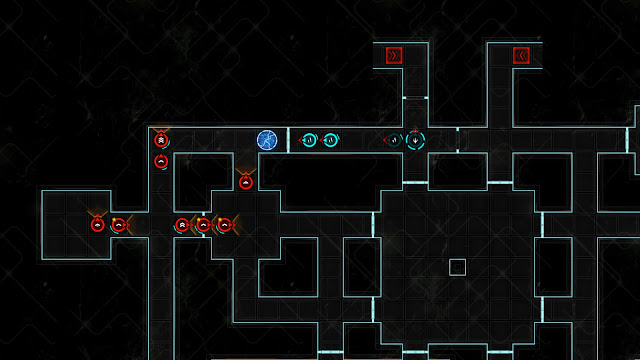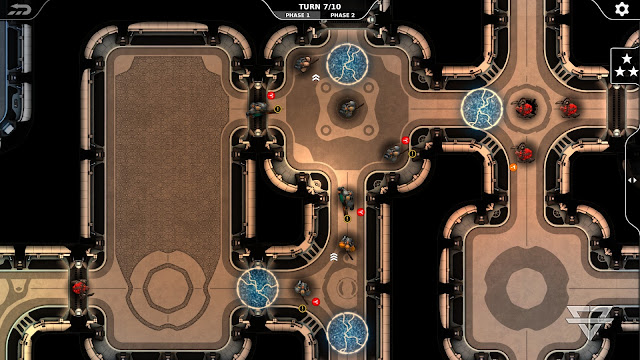Legions of Steel is honestly not some light and fluffy game in which unicorns shooting out rainbows of flowers and candy. What it is is a game about a race of machines that have been slowing combing over the galaxy and annihilating anything in their way as they strip everything bare of all useful resources. Galactic humans, really.
Forming an military alliance in order to attempt to save themselves, the largest militant races of the galaxy band together. Offering to help out any of the smaller races that would stand with them, these races are granted advanced technologies and are taught how to efficiently use them. Humanity is one such species lucky to receive such support. For all of our war like tendencies however, we didn’t have the actual numbers required to even be remotely effective on a larger scale. Taking this into account, squads of elite commandos were created in order to assist and take on difficult missions while the more populous species fight the big battles. This is where Legions of Steel kicks off.
This is one of those games where the story is told through its gameplay. Moving your troops down a corridor. Firefights around the corners. Last minute decision to launch a barrier cutting off your forces from backup to keep the enemy suppressed. Your actions, as commander of these soldiers, are what tells the story in between mission briefings and story segments. Using a comic book style to set up the story in cutscenes, the actual “story” is quite thin, but the player-created narratives can be exciting stuff indeed.
Legions of Steel is a slower paced tactical experience that allows for players to take all the time that they need in order to plan out their strategies. Using rounds to keep track of events, players will be sending their elite squad up against large enemy numbers in order to complete their objectives. The start of each round is determined by the roll of a dice to see who has initiative. Initiative can be modified if higher ranking officers on either side are present, making the quality of the leader essential in order to be able to grab the first strike in critical moments. The winner of the initiative is allowed to determine who goes first, also giving you the advantage of opting to go second and catch enemies in a trap if you can set one up.
Movement points are used for both moving and for turning. Need to move around a corner into a corridor but have to turn left first? That would be one point to step forward, one point to turn left, and then another two points to step forward into that corridor. Forgetting this can cause a few “really” good plans to fall apart rather quickly as units do not get into place on time, which is not uncommon in many strategy games, I know, but people whose tactical experience doesn’t extend far past the likes of XCOM might get themselves caught out a couple of times at first..
Because four movement points is really not enough at times, units have other options in order to help save on points or to simply add more. Each unit has the ability to “lock” their orientation in order to strafe. Strafing costs only one movement point to perform allowing a unit to move, shoot, and move back still keeping two movement points instead of having used all four. This especially comes in use when enemies are coming down a corridor of a building allowing your unit to pop into view for a quick shot and promptly pop back out keeping it momentarily safe from harm.
Another option that units can take is the ability run, which doubles the total movement points available. The downside is that actions that don’t involve movement are more difficult to execute, and accuracy in combat is lowered. Running is generally beneficial when everything along a chosen path is opened up and clear to run through. Finally, there is the inverse option in which the unit can opt to remain completely stationary, which increases the unit’s accuracy for either shooting down a long corridor or waiting for an enemy to come around the corner to better target them and land a hit.
While it might not sound like much in writing, in practice this can be a lot to take in all at once. With this in mind, it was great to have the comprehensive tutorial, which puts players into a range of different situations, allowing each strategy and manoeuvre to be tested out one after another and easing players into the complexity. While those I outlined above are only the basics, there are also loads of advanced techniques such as throwing grenades around corners, placing barriers, laying down suppressive fire, firing more than once in a turn, and doing targeted covering. Slitherine is of course known for its hardcore strategy games, and this one follows in suit.
The game’s engine provides plenty of opportunities for newcomers to ease themselves into the game, too. Once you move a unit, nothing is set into stone until a final action such as firing is taken. Moved to the wrong square? Hit undo. Turned in the wrong direction? Hit undo. There are some actions that can’t be taken back, and until I became intimately familiar with what I could take back I would occasionally be caught out by this, but for the most part I did appreciate being able to reconsider my basic strategies, at least.
With everything put together, Legions of Steel is a decent tactical experience. There did seem to be some issues with the data crunching, however, and I found that attacks that were listed as having a high percentage chance of success failed too often for what the numbers suggested. Nothing is a sure shot, but landing a failed mission because none of your forces could land a hit an enemy despite having acceptable percentages for three rounds can be a tad infuriating. The only reason that it didn’t downright ruin the experience was because the enemies are thankfully bound by the same questionable virtual dice.
Legions of Steel was great to sit down for long periods at time as there was never any rush to finalise my moves until you were ready. It’s a niche game, as all Slitherine projects are, but the publisher does have a deep understanding of what makes for a quality, deep, strategy game, and it has applied the same expertise to the tactics sub-genre with impressive results.
– Pierre-Yves L.
Contributor










